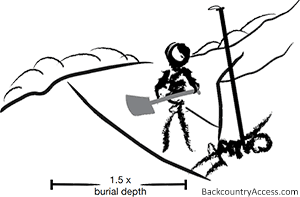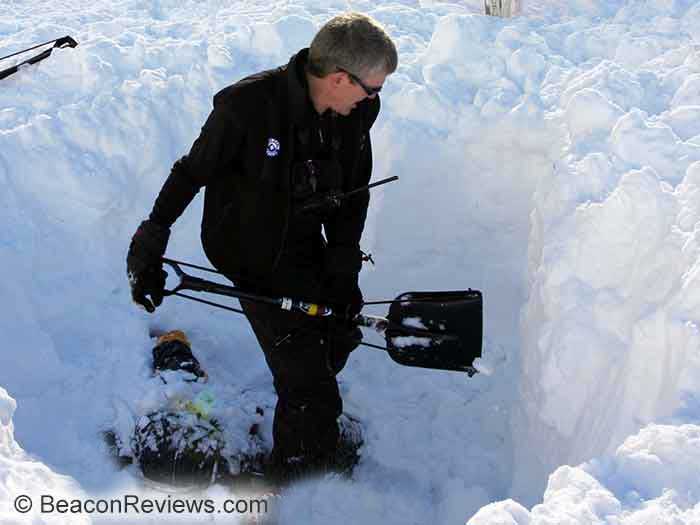Companion Shoveling
Companion shoveling (aka "
strategic shoveling") is the technique that is used during a typical backcountry accident or when a patroller is buried while on a control route. It is most appropriate when there are a limited number of rescuers. The key principals are:

With limited resources:
-
Shovel ergonomically (i.e., use your entire body not just your arms, kneel whenever possible, avoid bending at the waist, don't waste energy by throwing the snow further than necessary, etc). Try to conserve energy by shoveling snow only once.
-
In burials of a meter or more, move the snow to the sides first to preserve the downhill side to receive snow when the hole is deeper. You won't have additional rescuers to clear the snow.
-
If there are multiple shovelers, change the lead shoveler frequently.
See the
shoveling tips in the introduction to shoveling.
If there is one shoveler:
-
If the burial depth is one-meter or less, take one step downhill and start digging. (It's always preferable to start downhill of the probe, because there is less snow on the downhill side.)
-
If the burial depth is more than one meter, begin shoveling downhill of the probe approximately 1.5 times the burial depth. You can estimate the burial depth by looking at your probe, or simply take two steps downhill.

Steve recovering an avalanche victim
If there are two shovelers:
-
If the burial is relatively shallow (less than on meter), the two shovelers can work side-by-side.
-
If the burial is deeper, one shoveler can begin just downhill and the second shoveler can begin downhill of the first shoveler. Change lead shovelers frequently.
-
The lead shoveler can chop and sweep the snow downhill. The second shoveler can move the snow downhill and create a platform.
If there are more than two shovelers, you use a combination of the above based on the depth of the burial and the snow density. For example, you might have one or two rescuers near the probe, two or three rescuers behind the lead shoveler(s), three or four shovelers in a line, etc. If you have more than ~four shovelers, it's probably best to use
conveyor belt shoveling.
Don't get overly concerned with all the combinations of the burial depth and the number of rescuers. The key points are to start downhill, move the snow to the sides first, and trade position frequently. See the
shoveling tips, too.
